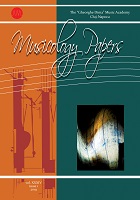The lutheran Chorale, an Overview of other Types of Chorales
The lutheran Chorale, an Overview of other Types of Chorales
Author(s): Anamaria LupuSubject(s): Music, Other Christian Denominations, Sociology of Art
Published by: MediaMusica
Keywords: Lutheran chorale; Protestant chorale; Lutheran reformation; Lutheran hymn; Martin Luther; Protestantism;
Summary/Abstract: Sixteenth-century Protestantism marked the entire history of culture and civilization and thus, implicitly, the history of music at least on a European level. The paper The Lutheran Chorale, An Overview of Other Types of Chorales, attempts to briefly capture the context of the emergence of the chorale during the Reformation, the most representative musical forms that developed based on the chorale, as well as a few hallmarks of the Protestant chorale. The chorale reflects a variety of musical styles, ranging from the medieval cantus firmus and the songs of the 16th-century meistersingers, to the continuo lied of the Baroque period. In a wider sense, the chorale can refer to two types of choral hymns: (1) cantus choralis – the Roman Catholic liturgical chant; (2) the Lutheran hymns of the German-Evangelical tradition. For the first 200 years after the Reformation, the chorale provided raw material for a wide variety of musical compositions, among which the chorale prelude, chorale motet, chorale cantata, chorale fugue, chorale partita, chorale fantasia, chorale mass, chorale variations, figured chorale, or chorale concerto. The promotion of the chorale (initially called Kirchenlied, or geistliches Lied, or geistliches Gesang) by Luther and his colleagues was a step of major importance in the history of church music
Journal: Lucrări de Muzicologie
- Issue Year: 34/2019
- Issue No: 1
- Page Range: 19-27
- Page Count: 9
- Language: English
- Content File-PDF

